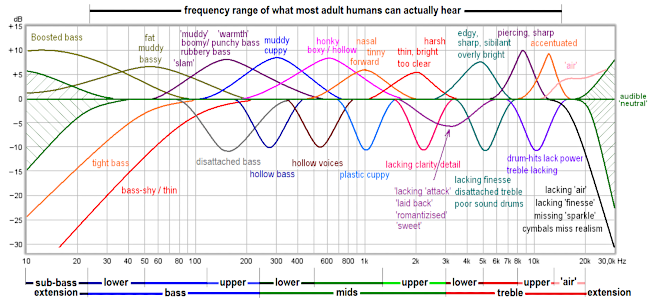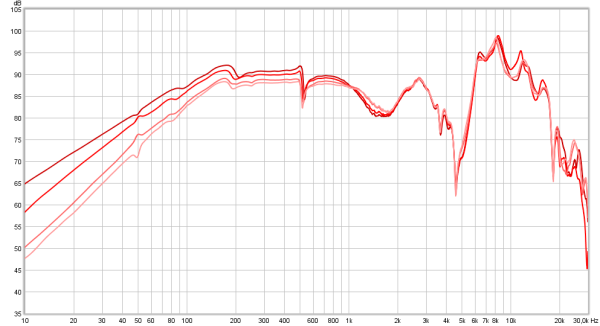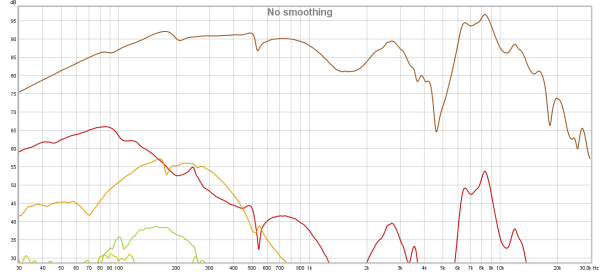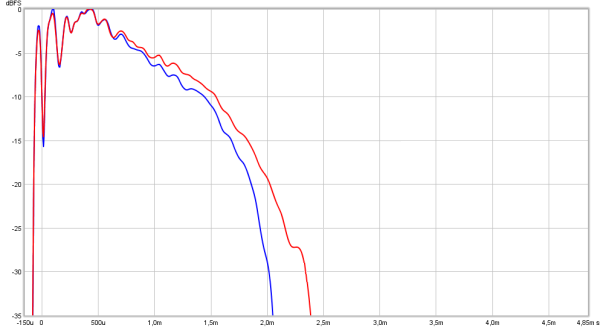K240 studio
back to AKG
back to measurements
home
published: May-01-2022
NO SMOOTHING is applied to the shown plots. Most measurement sites have some smoothing applied which ‘irons flat’ sharp peaks and ‘wiggles’. I do not use smoothing because some info about sound quality is lost when plots are smoothed.
Aside from a small correction of the microphone itself also some correction in the lowest frequencies is applied to the plots to compensate for the perceived loss of bass when using headphones. This is described HERE in more detail.
A ‘horizontal‘ frequency response curve on the shown frequency response plots on this website thus indicates a perceived ‘flat’ tonal signature.
ALL measurements are made with a good SEAL on a flatbed measurement rig.
The shape of your head, bone structure, pad size, pad ‘softness, (compliance), hair or no hair and or wearing glasses may (drastically) change the frequency response of some headphones, so… your personal experience may differ substantially from these plots.
Frequency response (tonal balance) is the most sound-determining aspect of headphones. A horizontal line shows audible neutral response in the plots on this website. Deviations in different severity at different frequency bands have an effect on the sound character.
The bigger the deviation the stronger the effect.
Below an aid to help determining the sound character of headphones with relation to the frequency response.
AKG K240 studio
The AKG K240 studio is a semi-open over-ear headphone. It costs around € 65.- and is yet another iteration of a long line of various ‘K240’ headphones. It is designed for studio usage. For music enjoyment AKG has a different line of headphones. The earlier models such as K240 Sextet, K240 M(onitor) and K240 DuoFoil (between 1975 and 1990) were 600Ω versions and had better bass extension and sound quality. The newer models all are 55Ω and have a lower sound quality when it concerns music enjoyment. These are cheap studio headphones intended for monitoring.
The fixed cable is 3 meter long and has a gold-plated 3.5mm plug on it with a 6.3mm screw-on adapter. On the headphone side it has a 3-pin mini XLR connector. The cable is microphonic so touching the cable or the cable rubbing against clothes is audible in the left cup.
The headband is self-adjusting and can adjust over a 15mm range. The headrest is plastic and isn’t padded.
L and R markings are located on the outside headband. Another give away for the left cup is the cable entry.
The metal frame of the headband is flexible and can be bent a lot in all kinds of directions without deforming. The 2 metal rods also act as conductors for the right driver. The solder joints on the metal have been known to be problematic for some headphones (wires coming loose).
The earpads are made of rather thick vinyl and will get ugly and crack over time (years). These can be sweaty and sticky when worn in warmer conditions. Fortunately they can be easily replaced and one can also use velours pads which increased the comfort.
With a sensitivity of 107dB/V (efficiency = 94dB/mW) and low impedance (55Ω measured) this headphone plays decently loud even directly from a phone and most audio interfaces.
The 0.2W power rating is high enough so it can reach 117dB SPL
This reviewed AKG K240 Studio is up for sale.
specifications:
Type: Over ear (circum-aural) semi-open
Usage: Studio
Driver type: dynamic
Pads: vinyl with firm foam.
Collapsible: no
Headphone cup connector: 3-pin mini XLR
Cable entry: single sided (left).
Cable: 3m straight in a gold-plated 3.5mm TRS jack with 6.3mm screw-on adapter.
Inner Pad dimensions: depth = 17mm, diameter = 56mm
Driver size: 30mm (effective diameter = 26mm)
Max. power rating: 0.2W (200mW)
Max. voltage: 3.3Vrms (9.4Vpp)
Max. current: 60mA
Max. S.P.L.: 117dB
Impedance: 55Ω (measured)
Efficiency: 94dB @ 1mW
Sensitivity: 107dB @ 1V
Weight: 235 g. (without cable)
Clamping force: medium-low (3N)
Accessories: 6.3mm adapter.
Subjective sound description:
Bass extension is completely lacking. So is lower bass. The absence of lower bass makes the bass sound ‘lean but tight’. Mids are ‘open’ and sound ‘dynamic’ but aren’t particularly ‘hi-fi’. When one wants to ‘isolate’ voices’ (monitoring) this headphone is well suited. The elevated treble is not an issue with monitoring and can kind of see why these headphones are often found in studios.
For music enjoyment the K240 studio is not really suited. Bass is lacking ‘body’, the mids even though dynamic sounding lack nuances and sound a bit ‘off’. Treble has a sharpness to it and lacks ‘finer nuances’ and has a ‘coarseness’ or ‘gritty’ sound to it.
Measurements:
Below the frequency response of the K240 studio (Left, Right) measured at 90dB @ 1kHz. The channel matching is very good. Bass extension and even low bass is lacking. From 150Hz to 1kHz the response is decent. Most of the human voice is within this range. From 1kHz to 6kHz the response is all over the place and too low in level. This affects clarity and even directional cues in music.
The channel matching is very good. Bass extension and even low bass is lacking. From 150Hz to 1kHz the response is decent. Most of the human voice is within this range. From 1kHz to 6kHz the response is all over the place and too low in level. This affects clarity and even directional cues in music.
From 6kHz to 9kHz the treble is elevated. This is in the ‘sibilance/sharpness’ frequency band.
It makes the sound more detailed but also too ‘sharp’ and ‘sssss’ sounds may be emphasized. For monitoring this is not a bad thing but for music enjoyment the wonky response between 1kHz and 18kHz is far less desirable.
phase response
Below the phase response of the K240 studio (Left, Right) Strangely enough the drivers are wired inverse in absolute phase opposite the normal convention. Not opposite each other though so stereo imaging is not affected. It also is not an audible issue. At 400Hz the phase is -180 degrees.
Strangely enough the drivers are wired inverse in absolute phase opposite the normal convention. Not opposite each other though so stereo imaging is not affected. It also is not an audible issue. At 400Hz the phase is -180 degrees.
Slow phase shifts are not very audible. Sharp changes in a narrow frequency bands may well be audible.
There is such a sharp shift at 500Hz (also seen in the frequency response). The sharp variations around 4.5kHz and above are not only sharp but also substantial. This , most likely, has a negative impact on the sound quality.
compared to
Below, alternating every 3 seconds, the K240 studio is compared to several other headphones.

The K240 has been on the market in many different forms/iterations over the years. All of these are called K240 but can differ in some aspects. Most of them have a similar appearance/construction though.
Above a comparison with another cheap headphone in the AKG stable with similar-ish looks as the K240 studio. This is the K92 which sounds very, very different. Also compared to a classic one, the K501 which has a similar bass response but more clarity. The K701 is another classic but still sold today. It has a fixed cable (just like the K612). The K702 is as good as the same as the K701 except for the color, replaceable cable (same connector as the K240) and pads. The K612 has a bit more bass extension than the K701/702 but these 3 models are more expensive than the K240 which is more a budget headphone.
There are also cheap ‘copies’ all made by Superlux for prices between € 20.- and € 50.- and marketed under various brand names (including Superlux). These, however, are inferior in build quality but much better in sound quality. In the comparison also the Superlux HD681 and DAP HP280 Pro.
Similar priced alternatives with better build quality (and very different looks) are the Roland RH5 and the well known Shure SRH-440.
output resistance / damping-factor
As this is a dynamic headphone the frequency response can be amplifier output resistance dependent when certain higher output resistance amplifiers are used.
Instead of showing impedance plots, which are hard to ‘read’ when it comes to assessing the tonal balance change in the real world, the K240 studio is measured via a few different resistance outputs (0.2Ω, 10Ω, 32Ω and 120Ω). On a higher output resistance amplifier the output level will be lower of course due to voltage division. To compensate for this the amplifier is cranked up to the same level (9.5dB for 120Ω at 1kHz in this case). This way the plots are overlaid and it is easier to see how the tonal balance changes. Output resistances between the mentioned resistance values will result in tonal changes between those traces.
The tonal balance in the bass changes when a higher output resistance amplifier is used.
This means that tonal balance can be different on devices like AVR’s and integrated amplifiers as well as higher output resistance (tube) amplifiers. Most audio gear in studios is between 1Ω and 30Ω.
It would be best to use audio gear that has an output resistance lower than 20Ω.
seal
Seal can be an issue with closed-back headphones and some open headphones. Breaking the seal (improper fit on the head) usually means a loss of (sub)bass. This can be caused by hair or glasses between head and pad or head shape combined with stiffer pads.
Perfect seal, seal broken by thin armed glasses, seal broken by thick armed glasses not resting against the skin. seal broken by slightly lifting the pads (small gap).
A broken seal has definitely a some influence on the tonality of this headphone. A small seal breakage is not really problematic as the bass is not well extended anyway. Breaking the seal more substantially results in a bit less bass.
As the driver used in the K240 studio is a bit small in diameter (for an over-ear headphone) it is hard to expect great bass performance. Below a picture of the driver. The effective diameter of the driver is only 26mm in diameter. Below the distortion measurements of the K240 studio (right channel). The measurements are made at 90dB SPL.
Below the distortion measurements of the K240 studio (right channel). The measurements are made at 90dB SPL. The plot above shows the level differences between the signal (upper trace) and the harmonics.
The plot above shows the level differences between the signal (upper trace) and the harmonics.
Most people prefer to see percentages instead of level differences so below the exact same plot except ‘normalized’ to the actual signal and level differences given in percentages. Distortion below 500Hz is rather high. Also 3rd harmonic distortion is elevated indicating compression. There clearly is some soft-clipping/compression going on below 500Hz as evidenced by the high 3rd and 4thand 5th harmonic distortion.
Distortion below 500Hz is rather high. Also 3rd harmonic distortion is elevated indicating compression. There clearly is some soft-clipping/compression going on below 500Hz as evidenced by the high 3rd and 4thand 5th harmonic distortion.
Below the distortion measurement performed at 80dB SPL. While the 2nd harmonic distortion is still quite high the higher order harmonics are at much better levels indicating at these levels (and below) the sound is not ‘soft clipping/compressing’.
While the 2nd harmonic distortion is still quite high the higher order harmonics are at much better levels indicating at these levels (and below) the sound is not ‘soft clipping/compressing’.
The actual 2nd harmonic distortion above 500Hz may well be lower than 0.1% . A shortcoming of my measurement rig.
compression
Based on these findings the linearity at different levels was also checked at 70dB, 80dB, 90dB and 96dB SPL (@1kHz). The different traces were normalized to 90dB at 900Hz so it is easier to spot compression. Also note the dB scale is 2dB/div.
The different traces were normalized to 90dB at 900Hz so it is easier to spot compression. Also note the dB scale is 2dB/div.
Above 80dB (which is ‘hiding’ behind the 70dB trace) some compression starts to happen.
Distortion thus is also increasing for lower frequencies above 80dB.
Below the CSD (waterfall) plot of the K240 studio (Left and Right are overlaid).  The driver appears to have some resonances around 3-4kHz and above 6kHz. The higher frequency ones are not long lasting resonances though.
The driver appears to have some resonances around 3-4kHz and above 6kHz. The higher frequency ones are not long lasting resonances though.
Below the Group Delay plot for the K240 studio (Left, Right) Due to the stiffness of the pads from 70Hz to 200Hz there is some ‘pad bounce’ visible.
Due to the stiffness of the pads from 70Hz to 200Hz there is some ‘pad bounce’ visible.
At 520Hz there is a substantial resonance present in both drivers which is also seen in the frequency response. At 4.5kHz there is another resonance. How much of this is audible in music remains to be seen as it is very narrow.
A different plot is the spectrum plot. This basically is a CSD (Waterfall) plot but viewed from above where the level differences are color coded instead of being in the vertical axis. Also the frequency range of the spectrum plot is wider (from 100Hz instead of 500Hz). The time span is also bigger in the spectrum plots and expired time is shown from below to top where in the CSD the time is shown from rear to front. Below the spectrum plot of the K240 studio (Left channel)  Bass frequencies (below 00Hz) do not linger on for long mostly because of the roll-off and driver damping. At around 500Hz we see the resonance also seen in the GD and FR plots. The driver seems to like to vibrate at this frequency. Above 900Hz the resonances that are there are short.
Bass frequencies (below 00Hz) do not linger on for long mostly because of the roll-off and driver damping. At around 500Hz we see the resonance also seen in the GD and FR plots. The driver seems to like to vibrate at this frequency. Above 900Hz the resonances that are there are short.
Step response
Below the step response plot which, when the sound is balanced and well extended should show a fast rise to around 0dB, (indicating fast driver response) and then should be slightly sloping downwards indicating bass extension. (Left, Right) Bass extension is quite poor given the horizontal part starts to drop quickly. Also a rather large resonance is seen as well.
Bass extension is quite poor given the horizontal part starts to drop quickly. Also a rather large resonance is seen as well.
pads
The ear-pads are made of rather thick vinyl and will get ugly and crack over time (years). These can be sweaty and sticky when worn in warmer conditions. Fortunately they can be easily replaced and one can also use velours pads which increased the comfort. Below the K240 fitted with original vinyl pads and the Superlux HD681V (velour) pads. AKG also sells K240 velour pads but these are more than 2x the price of the Superlux pads and feel/sound the same.

One can also use the Superlux softskin (thin pleather) HD681 pads which are softer than the original K240 vinyl pads but won’t last as long.
treble peak
Some owners do not complain much about bass and mids but do not like the treble peak.
Below the schematic for a treble peak filter for the K240 studio.
The effect of this filter is shown below versus the stock K240 studio. The sharpness is removed but treble extension remains the same. This cannot be achieved using some damping materials in front of the driver. Of course using parametric EQ the same can be done and the rest of the frequency response can also be corrected. Not everyone can use parametric or graphic EQ with this narrow bands. In such cases, when bothered by the sharpness, the passive inline filter is a very good option but may be a bit too expensive in a relative sense.
The sharpness is removed but treble extension remains the same. This cannot be achieved using some damping materials in front of the driver. Of course using parametric EQ the same can be done and the rest of the frequency response can also be corrected. Not everyone can use parametric or graphic EQ with this narrow bands. In such cases, when bothered by the sharpness, the passive inline filter is a very good option but may be a bit too expensive in a relative sense.
conclusion
The AKG K240 studio is a rather cheap semi-open over-ear headphone that carries the AKG brand name. The current line (K52, K72, K92) is very different sounding but not ‘better’. These headphones are nothing like the > € 100.- models AKG also sells. When one wants to stay within the AKG stable I would suggest the K612 or K702 (which has a replaceable cable like the K240).
For monitoring in a studio these headphones are fine though, certainly when on a budget.
The headphones feel a bit cheap but can take a beating. Comfort is not the greatest but one can wear these for hours without discomfort. Pad depth is a bit shallow and the pinnae may touch the baffle inside. The black and gold accents gives a ‘luxury’ look.
One can increase comfort a bit by using K240 velour pads or using the cheaper but similar performing Superlux HD681V (velour) pads.
With EQ one can improve on the sound quality a bit but adding deeper lows will result in higher distortion. Only when listening at softer levels this headphone has decent performance (with EQ)
Still, these headphones do not sound objectionable, just not really suited for people looking for audiophile sound and being triggered by the ‘professional’ label and seeing similar (looking) headphones being used in studios so they ‘must be good’.
Suited for monitoring, not good for mixing and even less suited for music enjoyment.
